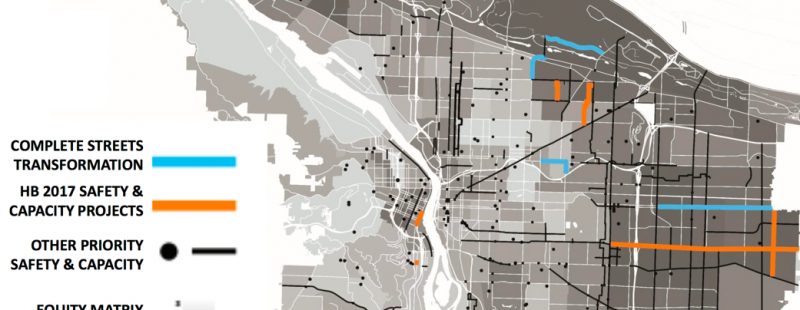
For the first time in decades, the Portland Bureau of Transportation has money to spend. Real money.
The typically cash-strapped agency has seen its fortunes take a major turn thanks to a combination of new funding sources: There’s the Fixing Our Streets program that’s funding a $64 million list of projects through 2020; an increase in Transportation System Development Charges thanks to booming growth; and Mayor Ted Wheeler’s $50 million Build Portland initiative just to name a few.
Then there’s the money coming to PBOT from the state transportation package (a.k.a. House Bill 2017) that was passed over the summer. PBOT is dividing up an estimated $15 million per year in discretionary funds from HB 2017 — that’s on top of set-aside funds coming from Salem for Safe Routes to School and other projects.
All told we’ve heard PBOT could have about $40-60 million a year to spend. By accounts of some veteran staffers we’ve talked to, that’s more than they’ve had in the piggy bank since the late 1990s.
At a meeting of the Bicycle Advisory Committee (BAC) earlier this month, PBOT planner Zef Wagner and Shoshana Cohen from their finance group shared the agency’s latest thinking on how it should be spent.
Advertisement
Before you get too excited, $40-60 million is a lot relative to what PBOT usually has; but they still claim to have $3.6 billion (with a “b”) in unmet maintenance and “safety and capacity” needs. Even so, the mere fact they’ve got a presentation titled “PBOT Investment Strategy” is a good sign.
PBOT outlined three major goals that will steer their investment decisions: manage existing assets, vision zero, and manage future growth. With an eye toward leveraging other funding sources, PBOT said they’re looking for “triple win” projects that touch on all three of those goals.
They shared a draft list of five “transformative triple win” projects that would total $61 million from a number of different sources. The projects are essentially complete rebuilds of big sections of outer SE Stark, the 42nd Avenue Bridge, NE Cornfoot Road, NE Halsey and NE 60th, and SW Capitol Highway:
And another five projects (some of which have already begun) have made a list labeled as “double win investments in safety and capacity”:
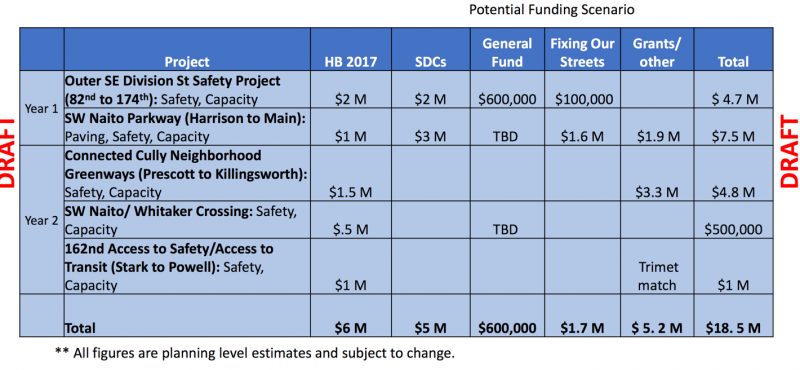
Portland City Council recently agreed to set-aside $5 million to rebuild the 42nd Avenue Bridge (over Lombard). That new bridge could tie into existing plans and work by PBOT on NE Cornfoot and Alderwood — main cycling routes to the Portland airport. With the neighborhood greenway on NE Holman that feeds into 42nd, Wagner said, “We could create a cohesive protected bike lane network to get to the airport.”
PBOT shared the maps below to show how these “transformative” projects align with adopted goals related to equity, safety (high crash network), and proximity to commercial centers and freight districts:
PBOT’s Wagner says this unprecedented confluence of funding sources offers the city a major opportunity. Instead of patchwork projects done on-the-cheap, there might be a chance to make major updates to a few key routes and finally begin to “bend the curve”.
“If we could combine Build Portland, HB 2017 and SDCs, we could really upgrade parts of the roadway… the type of thing we’re rarely able to do,” Wagner said. “We could reassess the character of the roadway.” Wagner also said the Bike Plan for 2030 is already seven years old and “It might be time to refresh that [project] list.”
Aligning different funding sources sounds easy, but red tape and bureaucratic turf wars often make it difficult.
If you’ve been dreaming of a major project in your neighborhood, now’s the time to ask PBOT for it. Make sure you’ve done your homework by read through the investment strategy first.
— Jonathan Maus: (503) 706-8804, @jonathan_maus on Twitter and jonathan@bikeportland.org
Never miss a story. Sign-up for the daily BP Headlines email.
BikePortland needs your support.


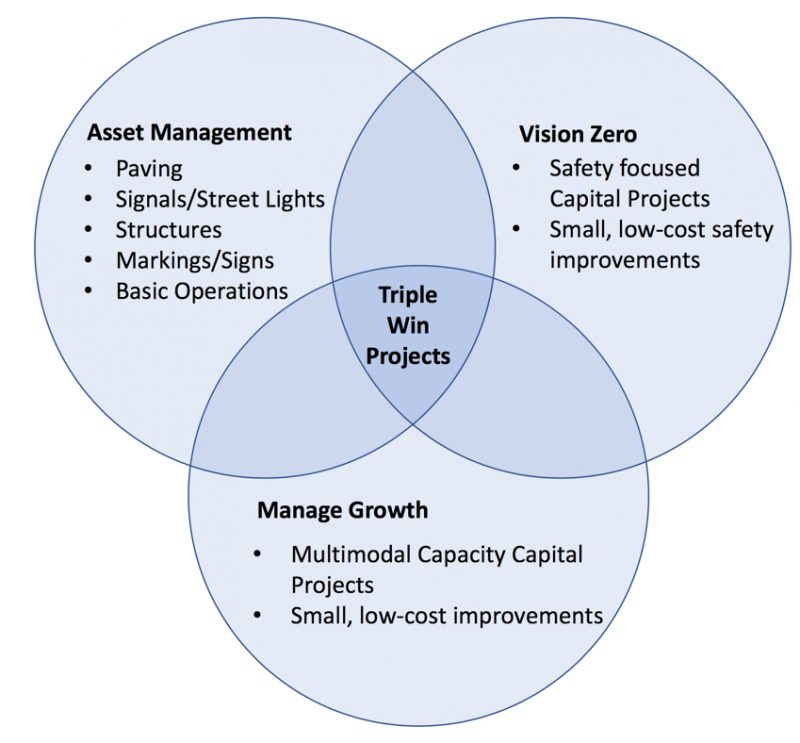
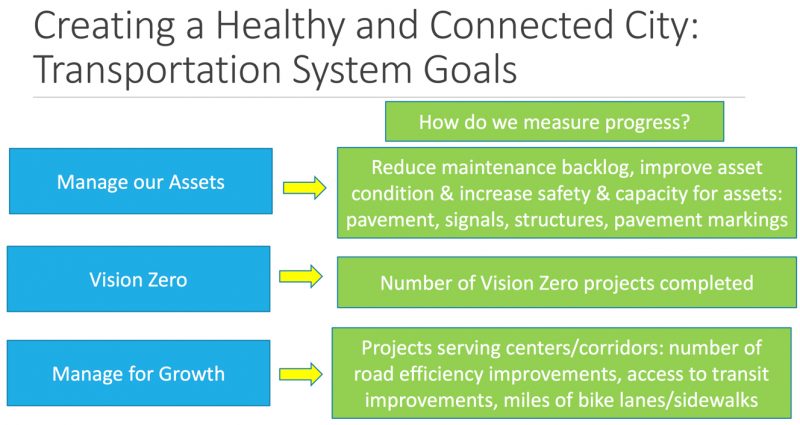
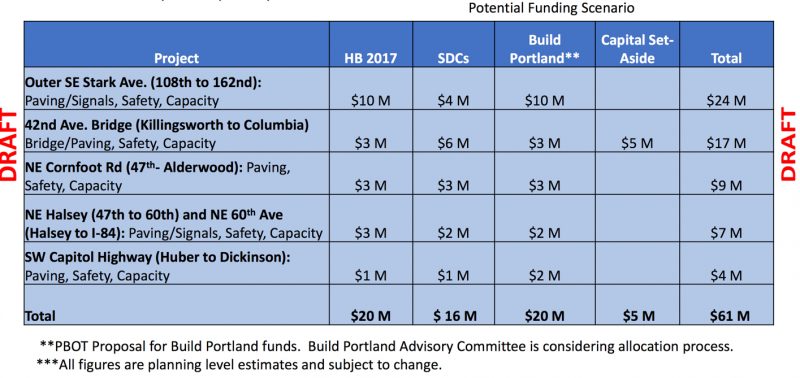
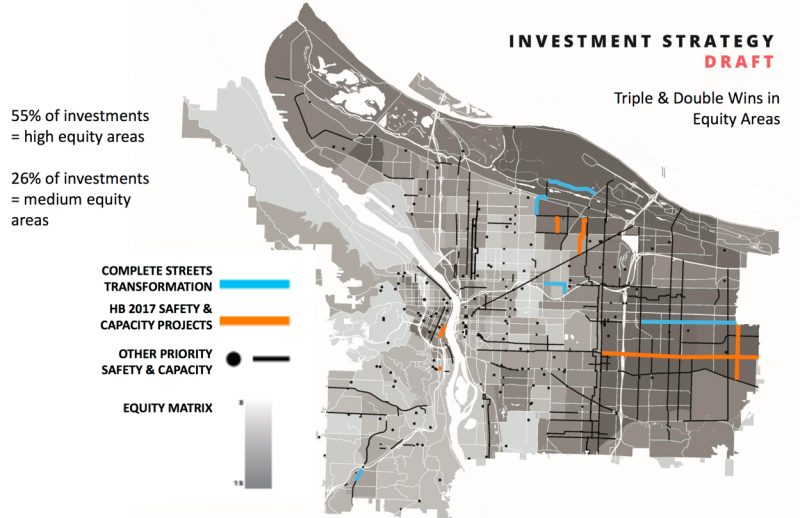

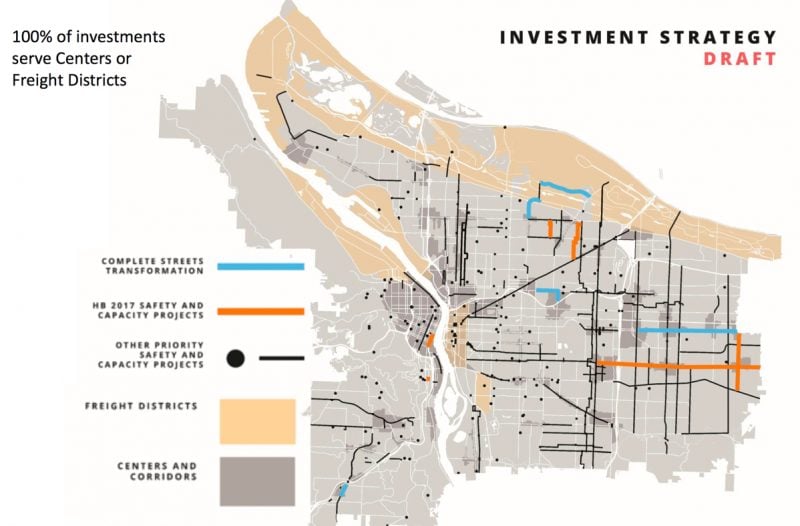

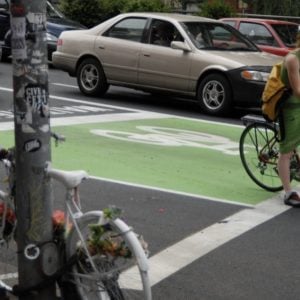

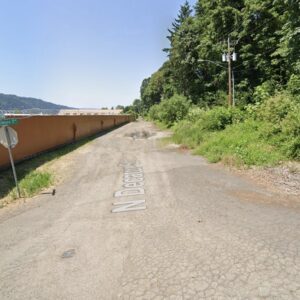
Thanks for reading.
BikePortland has served this community with independent community journalism since 2005. We rely on subscriptions from readers like you to survive. Your financial support is vital in keeping this valuable resource alive and well.
Please subscribe today to strengthen and expand our work.
My immediate reaction – very encouraged to see the focus on east of 82nd.
is Foster Blvd. going to actually be accomplished, or should we expect another 3+ years of delay?
it’ll happen. on PBOT time. Last I heard plans are finalized and have been approved. not sure exactly why it has taken so long. Perhaps someone else here knows?
https://www.portlandoregon.gov/transportation/article/540950
“Schedule
Update: Summer, 2017
Design engineering for the project is nearing completion. This fall, the project will enter into its final sign approval and authorization for to proceed to construction. We currently anticipate that the project will go to bid for a construction contract in January of 2018, with construction starting in mid to late spring of 2018. Construction is anticipated to take 6-7 months to complete.
Once a contractor has been selected through the bidding process we will have more detailed information about the construction schedule.”
another excuse, another delay.
I don’t follow. There’s no excuse there. Just a couple of simple statements about the status and when it’ll go out to bid. Am I missing something?
the project was approved by council in 2014 and was put out for bid and delayed.
do not hold your breath this time around.
That bid would have been for the design work, yeah? Have you ever done engineering work? Designs take a long time, especially with all the dead time waiting for and then addressing public comments. The fact that they’re still in the design phase seems normal to me. Going out to contractor bid by next year seems reasonable.
Again, I still don’t know what was meant by “excuses”. I still see none.
paul hobson, the bid was not for the design phase — it was for the construction of the first-phase of the foster-street scape project.
deja vu.
“PBOT time” hasn’t been very reliable, unless it’s a pet project. We’ll see if they’re tooled up to “really” make a difference. Let’s see how they do with some funding in pocket. I want to see concrete on the ground and projects from the 2030 Plan implemented, or new leadership! “What have you done for me lately”?
PBOT time:
“Immediately” = Any time between now and three years after the hiring of the next PBOT director.
“Soon” = 5-10 years; 3-7 with good behavior.
“Subject to a study” = 10-15 years. Studies are only good for 12 years.
“Scheduled in the TSP” = Never. Is that soon enough for you?
1) project funded
3) intergovernmental agreements 2-5 years
2) design 4-10 years
3) funding too low for bids OR unforeseen “complexity”
4) synergy with another project is **SUDDENLY** discovered
5) new design phase
6) goto 1
You may have forgotten the NEPA process (environmental impact), which in Oregon is 1-3 years, while here in NC can delay projects up to 10 years. Sometimes it’s part of the design process.
Invest in that one trail project approved by city council in 2007 to help outer SW ?
This link ? https://bikeportland.org/wp-content/uploads/2017/11/Final-BAC-Meeting-11.14.17.pdf
I noticed the part about how PBOT measures success. For the Vision Zero projects, success is measured by the number of projects completed. Shouldn’t it be measured by decrease in death/serious injury crashes? Or am I missing the whole point of Vision Zero?
Hi mark, that’s a very astute observation. You are correct. The only measure of success for VZ is a decrease in crashes, injuries, and deaths.
I was at the PBAC meeting as a guest, and so didn’t want to yell out. But that statement stuck out like a sore thumb, and nobody questioned it. This highlights a major flaw in our administrative system – for bureaucrats, it seems to be a system of numbers on paper/screens, that is very removed from the physical reality of our city. It does not inspire hope or confidence.
if the BAC had more insiders whose companies/ex-companies received city/state transpo funding it would certainly play a more active role in decision-making processes.
It seems like we have been infected by these useless checklists when we would be better served with a more holistic view. While hammering together projects, both details and the project itself should constantly have to answer the question, “Does this help further our mission of reducing crashes and their severity while increasing the mode share of active transportation and serving people with mobility issues equitably?” (or some other global mission statement).
Instead we have far too many projects in which the operation was a success, but the patient died.
I worked at the University of California back before the President and Chancellors thought of themselves as CEOs. Major and minor projects were constantly viewed through the lens of the University mission statement, and it was taken seriously. The result was a public university system that was the envy of the world. PBoT could do with a bit of that.
One of the key actions from the City’s Vision Zero Action Plan around street design is:
Build capital safety improvements on two segments and five intersections in the High Crash Network each year, prioritizing improvements in and engaging with Communities of Concern
They require that any ‘Vision Zero’ capital project “Allocates a majority of the project cost to safety countermeasures* that address a specific, documented safety risk”
So yes, numbers are important in meeting this action item – which is one of their most ambitious. And in addition to the number of projects, they should also be meeting that VZ capital project definition. It will be important to track these projects to ensure that is the case.
Their performance measure for this action is:
Annual average number of deadly and serious crashes on improved segments, disaggregated by mode, age, and geography, compared to prior 5-year annual averages in the same segments
So, how the projects are reducing crashes is indeed part of the equation. Again, always important to be tracking that these things are indeed happening – but to me, this presentation aligns with what the action entails.
https://www.portlandoregon.gov/transportation/71735
Thank you for this Noel. Good to remember to refer back to the VZ Plan when stuff like this comes up.
I would think that a focus on fixing all the known gaps in the bike network would be a priority. I think a strong focus on East Portland is the necessary first place to look, but I think a concurrent push to patch all the gaps that prevent the individual bike routes from becoming a network that functions for a wide range of people would be a real game changer in terms of ridership numbers. The gap that I think would be the very best investment is completing the bike lanes along Skidmore between Michigan and 7th. This gives protected crossings with existing signals (low cost for PBOT) at MLK, Williams and Vancovuer. There are already bike lanes over I-5 and using a signal at Interstate. This segment of bike infrastructure would connect commercial districts along NE Alberta, Mississippi, Interstate and N Killingsworth. It would also interconnect the bike routes west of I-5 (Interstate, Going to Swan Island, Concord, Greeley) to the bike routes on the east side of I-5 (Going, Michigan, Vancouver/Williams, future 7th, Rodney). For a relatively low cost and the removal of parking, the network gets a huge boost in connectivity.
Blandena/Going is only a couple blocks north of Skidmore. Hard to see it as a huge priority.
Blandena?Going is a meandering mess that is impossible to follow. It does not have an at-grade crossing of I-5. It does not have protected crossings at MLK, Vancouver, Williams, Albina/Mississisppi. Blandena/Going is a pathetic joke of a transportation route that is hobbling the inner Noth/Northeast bike network. Blandena/Going is emblematic of what is broken at PBOT and what should be replaced with something simple, inexpensive and functional!
Inexpensive?
pray tell what your ‘protected crossings’ look like in your simple world.
RRFB $75k/crossing
PHB $150k/intersection
Full signal $300k/intersection
without even evaluating ‘need’?
It would be inexpensive because the signals are already there! The bike lanes just need to be extended along Skidmore from Michigan to NE 7th. I definitely do NOT think it is a good use of limited dollars to install expensive blinking lights along the Going route between 7th and Interstate because that route is a preposterous jumble.
Huh. I sure thought it was one of the most popular bikeways in Portland, rather than the hellscape you are describing.
Protected bike lanes on 122nd, Foster Road to Marine Drive.
The Fixing Our Streets corridor safety project will likely include protected bike lanes of some sort.
There’s a huge difference between planning and execution.
Just look at the last two bike plans and then at what actually got built.
those were mostly unfunded plans…
PBOT is still in deficit spending mode even with this supposed new infusion of cash, my prediction is that a good chunk of what they are currently discussing will also go unfunded.
All transportation departments are always in debt, that’s how they fund projects NOW, rather than waiting until they have funds and watching city council suddenly take the funds away from them to fund parks, police, homeless shelters, etc. It’s called “deficit spending”, usually using bonds paid for with future funding streams, such as parking revenue, gas taxes, ULF, etc.
I have no doubt that PBOT will fund the projects listed, I just have doubts they’ll ever actually build them. They’ll scope out projects, design them, engineer them, send them out for public review, redesign them based upon public input they like (and ignore the rest), more public review, then redesign based for Vision Zero, then cancel or delay the project to re-allocate funds for a pet project. By the time it’s built, 15 years later, the value of funds will decline by a third, while community priorities will change radically.
So we agree. 🙂
PBOT is broken, no amount of positive spin and PR is going to improve things on the streets until they radically change their business model; which, IMO is not likely to happen any time soon given the amount of power and control older ‘traditional’ engineers still have inside PBOT.
I totally agree.
also agree.
Looking at the comments, I can’t help but feel that PBoT has burned its reputation with cyclists and cycling advocates by constantly promising great things, game-changers, and then delivering more of the same-old-same-old dressed up with nicer shades of lipstick. The pig to which I refer is an approach that puts car speed and throughput above all else. How else do we explain the fact that we still have buses stuck in traffic and door-zone bike lanes?
At this point, it’s going to take some major improvements in the facts on the ground before PBoT can make announcements that aren’t met with rolled eyes. That’s actually a shame because PBoT, for all its failings (plenty of those) does have some people who are really trying to do the right thing. They’re mostly failing, but they are trying. It’s not always their fault, but until I see PBoT staffers picketing in front of ODOT and constantly testifying to state legislators, I’m not feeling the love.
Unfortunately, many of us advocates also drank the same koolade, we believed what planners at PBOT (and BPS) told us, without ever consulting directly with the engineers. Planners in general are “yes-people”, a bit like cheerleaders, they are convinced that government is good, that they are there to help us, and enthusiastically support anything that is progressive, but without ever consulting engineers beforehand. We pay engineers to be right, which means they often say “no”, but because the planners often act as a screen (probably unintentionally), we as advocates never hear those “nos” until after projects are already funded.
Halsey from 47th to 60th is badly in need of a road diet. Unfortunately, it is too narrow for standard bike lanes if they want to have a median turn lane.
It could be done, given the current lane configuration and street width. The travel lanes and the turn lane would all need to be no more than 10 feet wide (9 feet is the federal minimum), and the bike lanes 5-feet wide, but it can be done. At least here in NC it has been done.
I like it. I think PBOT is headed in the right direction.
I appreciate PBOT’s focus on East Portland, but from the look of the maps, they are still focusing on discrete segments. The existing network is riddled with frustrating gaps and dangerous missing links that prevent ridership from growing and establishing. I hope that all new projects will make strong,safe and simple connections to other bike networks.
I also hope that PBOT can devote more time and money into filling in the well-known gaps in the existing network
$21M for NE 42nd to 47th x Columbia, and NE Cornfoot Rd. seems an extremely large piece of the budget for what purpose? Recreational or access to jobs? I don’t quite get what the priorities are. Working down on Columbia, I get that access to jobs by bike or transit are marginal. But lacking data or explanation, it appears to be a ‘road to nowhere’. Anyone care to enlighten me?
Because those roads are currently two lanes with no shoulders or sidewalks. It’s a major project to add bike lanes and sidewalks. And, yes, access to employment.
Portland bid for Amazon HQ: Employment access to the airport FedEx and USPS facilities.
Amazon is already committted for the Meadowlark project in Rivergate…5k jobs, not visionary but coming. Would not working on completing npGreenway be a more timely effort?
You are thinking logically. The city EcDev folks (PDC) are probably visioning something more dramatic, with stronger airport connections, rather than port connections.
Can anyone from PBOT explain why the project costs above are so much higher than the costs in the TSP project list? i.e. Cornfoot Rd Corridor Improvements is estimated at $3.6 million in the TSP, but based on the investment strategy would be a $9 million project. Surely the re-paving can’t cost $5.4 million?
2007 TSP or not yet approved update?
Planning estimates are not conservative enough.
TSP project list, as adopted by City Council on June 15th 2016.
https://www.portlandoregon.gov/transportation/article/620127
The $9 million figure is likely based upon the recent reconstruction of SE 136th between Division and Foster. The TSP project #40036 only calls for new paths, shoulders, and guard rails – repaving the street is extra.
These include paving and signal replacements, because asset replacement is the only thing the Build Portland funding can be used for. The TSP typically doesn’t include asset maintenance, though perhaps it should given these new funding sources. For Cornfoot, the multi-use path is $3.2M and the rest is paving cost.
Oh, and yes, you better believe paving costs $5.4 million. Cornfoot needs a deep grind-and-pave, and reconstruction in some areas.
Pretty sure if PBOT surveyed Portlanders, not a single one would suggest replacing the overpass at 42nd was a top priority.
Nor would they Cornfoot Road for that matter.
82nd, Foster, Lombard and 122nd are a mess and inconvenience tens of thousands of people daily with their sub-standard sidewalks, poor condition, few crossings and sewer-like appearance.
Clearly, whatever rubric they employed is inaccurate if this is the results it returned.
Hi Kittens,
I hear what you’re saying. But I think the 42nd Ave bridge is a seismic concern.. which puts it in a different bucket than other projects. And the Alderwood/Cornfoot stuff is based on SDCs due to the industrial zoning out there AFAIK. Not to mention that improving access to the 1000s of jobs north of Lombard and Columbia is a major need for our city. I personally think unlocking a safe access for bicycling to Marine Drive and the Portland Airport is a major priority.
82nd is an ODOT road. ODOT is doing nothing substantial to make it better.
Lombard is also an ODOT road. see above.
Foster is getting a major overhaul. See the Foster Streetscape Project.
122nd is also getting a lot of investment from PBOT. Not enough of course, but they do have projects going on there too.
ODOT has offered to give any of its “orphaned highways” to PBOT, including 82nd & Lombard, as long as PBOT accepts them “as is”. As with inner Sandy, which used to be an ODOT facility, PBOT will only take ODOT roads that have been substantially rebuilt. Currently only outer Powell is scheduled to be rebuilt, then handed over to PBOT.
ODOT offered orphans with some funding several times but the city council traditionally favors political expediency over the lives of portlanders.
Nope. The Cully neighborhood, Verde, Living Cully, Hacienda CDC, NAYA, Columbia Corridor Association, and many other organizations in the area actually do think it is a top priority, and many of them have directly advocated for it to be funded.
The other thing to keep in mind is that Build Portland funding can only be used for City of Portland asset replacement, so the idea is to combine funding to do safety and multimodal capacity improvements at the same time as paving or bridge replacement. 82nd and Lombard are owned by ODOT, so they are not eligible. 122nd and Foster are already getting quite a bit of paving and safety improvements through other upcoming projects.
Respectfully, you’d be wrong — I’d certainly put both of those near the top. The poor condition of the 42nd bridge and the poor pavement condition and lack of even a cursory bike lane on Cornfoot are serious barriers to my daily bike commute to PDX. It’s a mess on a good day. On a day where visibility is even a little bit iffy, it’s dangerous (and I won’t do it — I drive instead).
There are plenty of other barriers to address (like the dangerous game of frogger one must play at Cully/Columbia/Alderwood), but this is a good start.